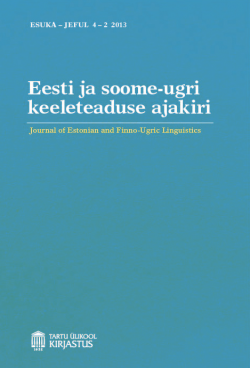Contact-induced sound change: analysis of the alveolar lateral fricative in Yami
DOI:
https://doi.org/10.12697/jeful.2013.4.2.02Keywords:
language contact, sound change, speech community, social network integration, cross-linguistic influence, YamiAbstract
Language change manifests itself in various ways. The majority of studies on language change in Yami, an endangered Austronesian language spoken on Orchid Island, Taiwan, have centered on the rapid language shift from Yami to Mandarin within the speech community (Chen 1998, Li and Ho 1988, Lin 2007, Rau 1995). The present study, however, aims to explore whether the sound change of [ɮ] to [l] in Yami (e.g., soli [ʂuɮi] > [ʂuli] 'taro') is triggered by language contact between Mandarin and Yami. Three variables were considered: Mandarin competence, Mandarinspeaking frequency, and social network integration. The results showed that the three variables were strongly correlated with sound change. Participants possessing advanced Mandarin competence, higher Mandarin-speaking frequency, and/or weaker social network integration into the Yami community (i.e., greater exposure to Mandarin) tended to exhibit the highest rate of sound change, which might be attributed to a cross-linguistic influence from Mandarin to Yami through extensive language contact.Downloads
References
Asai, Erin (1936) A study of Yami language: an Indonesian language spoken on Botel Tobago Island. Leiden: Universiteits boekhandel en Antiquariaat J. Ginsberg.
Blust, Robert A. (2009) The Austronesian languages. Canberra: Pacific Linguistics, Research School of Pacific and Asian Studies, Australian National University.
Chambers, Jack K. (1995) Sociolinguistic theory. Oxford: Blackwell.
Chen, Hui-Ping (1998) A sociolinguistic study of second language proficiency, language use, and language attitude among the Yami in Lanyu. Unpublished Master’s Thesis. Taichung: Providence University.
Crowley, Terry and Claire Bowern (2010) An introduction to historical linguistics. Oxford: Oxford University Press.
Ministry of the Interior (2012) Department of household registration, ministry of the interior. Available online at <http://www.ris.gov.tw/zh_TW/346>. Accessed on 10.02.2013.
Fishman, Joahua A. (1965). “Who speak what language to whom and when”. La Linguistique 1, 67–88.
Map of Orchid Island, Taiwan. Available online at <http://goo.gl/maps/f2YzU>. Accessed on 10.02.2013.
Hammarberg, Björn (2001) “Roles of L1 and L2 in L3 production and acquisition”. In Jasone Cenoz, Britta Hufeisen, and Ulrike Jessner, eds. Cross-linguistic influence in third language acquisition: psycholinguistic perspectives, 21–41. Clevedon: Multilingual Matters.
Ho, Yueh-Ling (1990) Yami structure: a descriptive study of the Yami language. Unpublished Master’s Thesis. Hsinchu: National TsingHua University.
Labov, William (1980) “The social origins of sound change”. In William Labov, ed. Locating language in time and space, 251–266. New York: Academic Press.
Labov, William (1994) Principles of linguistic change. Vol. 1: Internal factors. Oxford: Blackwell.
Labov, William (2001) Principles of linguistic change. Vol. 2: Social factors. Oxford: Blackwell.
Lai, Li-Fang (2011) Language contact and language change on Orchid Island. Unpublished Master’s Thesis. Taipei: National Taiwan Normal University.
Lavoie, Lisa M. (2001). Consonant strength: phonological patterns and phonetic manifestations. New York: Garland.
Letica, Stela and Sandra Mardešić (2007) “Cross-linguistic transfer in L2 and L3 production”. In József Horváth and Marianne Nikolov, eds. UPRT 2007: empirical studies in English applied linguistics, 307–318. Pécs: Lingua Franca Csoport.
Li, Paul Jen-kuei and Yueh-Ling Ho (1988) “Preliminary research report on Yami on Orchid Island”. Newsletter for research in Chinese studies 7, 4, 224–232.
Li, Paul Jen-kuei (1992) Orthographic systems for Formosan languages. Taipei: Ministry of Education.
Lin, Jasmine Yi-Hui (2007) A sociolinguistic study on Yami language vitality and maintenance. Unpublished Master’s Thesis. Taichung: Providence University.
Lippi-Green, Rosina L. (1989) “Social network integration and language change in progress in a rural Alpine village”. Language in society 18, 213–234. http://dx.doi.org/10.1017/S0047404500013476
McMahon, April M. S. (1994). Understanding language change. Cambridge: Cambridge University Press. http://dx.doi.org/10.1017/CBO9781139166591
Milroy, Lesley (1987) Language and social networks. 2nd ed. Oxford: Blackwell.
Odlin, Terence (1989) Language transfer: cross-linguistic influence in language learning. Cambridge: Cambridge University Press. http://dx.doi.org/10.1017/CBO9781139524537
Rau, Der-Hwa Victoria (1995) “Yami language vitality”. Paper presented at the Conference on language use and ethnic identity, Institute of Ethnology, Academia Sinica, Taipei, 16.06.1995.
Rau, Der-Hwa Victoria and Maa-Neu Dong (2006) Yami texts with reference grammar and dictionary. Taipei: Institute of Linguistics, Academia Sinica.
Ross, Malcolm (2005) “The Batanic languages in relation to the early history of the Malayo-Polynesian subgroup of Austronesian”. Journal of Austronesian Studies 1, 2, 1–23.
Sharwood-Smith, Michael and Eric Kellerman (1986) “Crosslinguistic influence in second language acquisition: an introduction”. In Eric Kellerman and Michael Sharwood-Smith, eds. Crosslinguistic influence in second language acquisition, 1–9. Oxford: Pergamon Press.
Taitung County Government (2011) Taitung county budget, accounting and statistics department. Available online at <http://www.taitung.gov.tw/statistics/p3/12345/p3/2.htm>. Accessed on 13.10.2012.
Ministry of the Interior (2007) Taiwan administrative region map. Available online at <http://taiwanarmap.moi.gov.tw/moicpe/GetImage.aspx?city=Taitung%20County&town=Lanyu%20Township&cg=new>. Accessed on 23.09.2012.
Thomason, Sarah G. (2001). Language contact: an introduction. Washington DC: Georgetown University Press.
Tsao, Feng-fu (1997a) Language policy on ethnic groups: a cross-strait comparison. Taipei: Crane.
Tsao, Feng-fu (2004) “Language policy and language education in Taiwan”. In Wah Kam Ho and Ruth Wong, eds. Language policy and language education in East Asia, 307–328. 2nd ed. Singapore: Eastern Universities Press.


